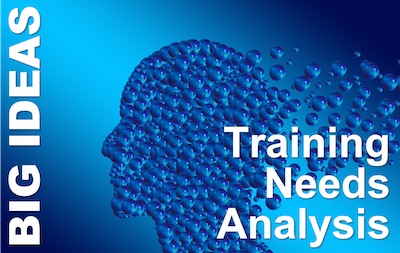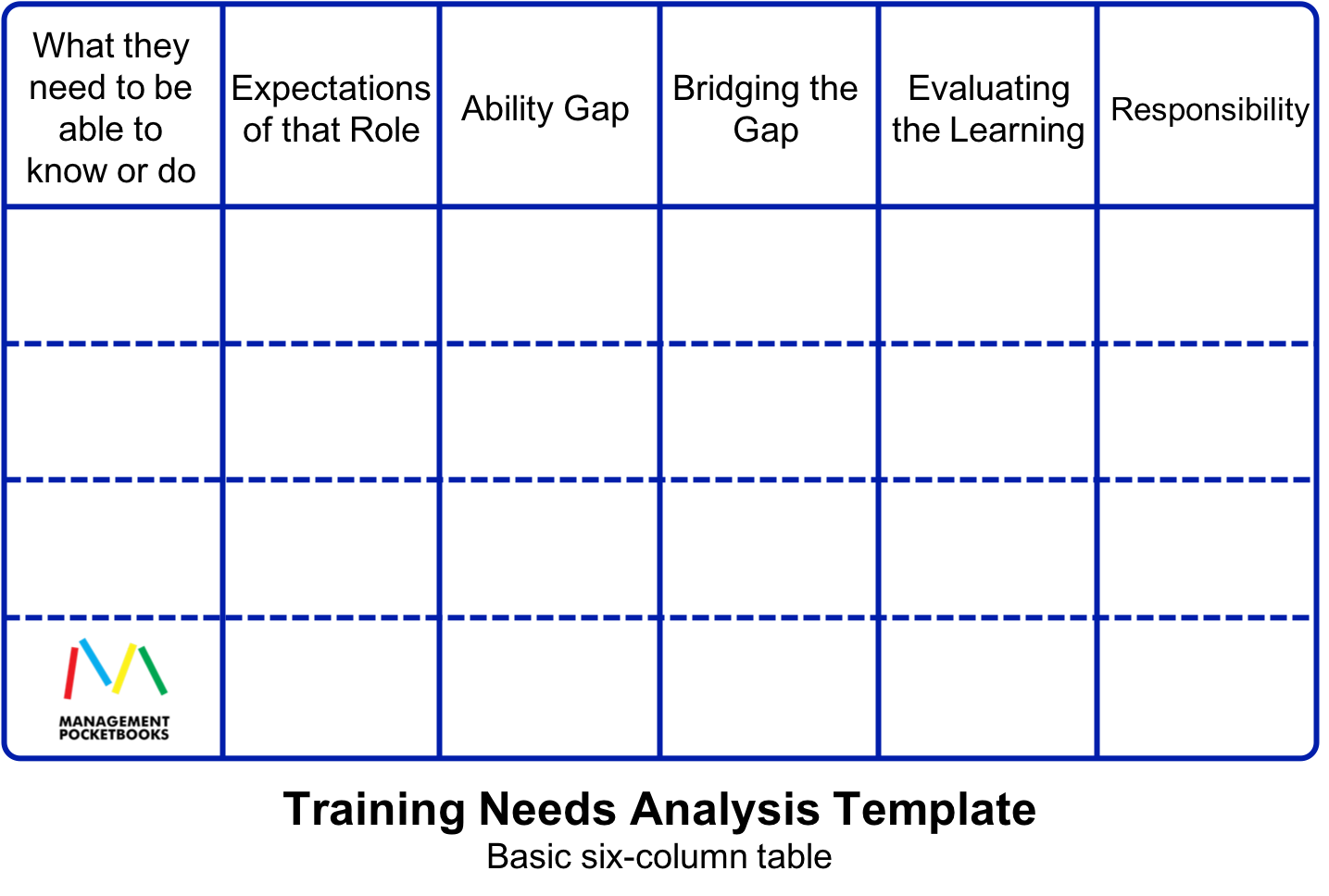
 Training Needs Analysis (TNA) is now increasingly referred to as Learning Needs Analysis (LNA). This is a reflection of the far wider range of options for how we learn at work. But, regardless of terminology, just what is Training Needs Analysis, and how can you do carry it out?
Training Needs Analysis (TNA) is now increasingly referred to as Learning Needs Analysis (LNA). This is a reflection of the far wider range of options for how we learn at work. But, regardless of terminology, just what is Training Needs Analysis, and how can you do carry it out?
At the heart of this Big Idea is a recognition that we all need to learn new stuff, to improve our work performance. Life-long learning is a good thing in itself. But as job roles change, and as we move through our careers, it is a necessary part of working life too. So, Training Needs Analysis does what its name implies: it is an analysis of the training or learning we need, to do our job (or our next job) as well as possible.
Why Conduct Training Needs Analysis?
All organisational leaders want their organisation to perform better. To reach its optimum.. and then go forward.
This means that the people in the organisation need a full set of capabilities and competencies. And they need them to the highest standards.
Fundamentally, TNA is a way to understand the gap between:
- the current performance of an organisation and the individuals in it, and
- the desired performance of an organisation and the individuals in it
As a result, we need to assess:
- who needs training or learning?
- what training or learning they need
- how to design effective learning and training for those people
- the impact of the training we are planning
- the cost and resource budgets, to assess value for money
What is Training Needs Analysis?
Training specifically, and learning more widely, is the way we help people improve their performance at work.
Training, or Learning Needs Analysis is the process of:
- Understanding the performance improvement we need,
- Relating that to skills, competencies or capabilities
- Figuring out what people need to learn
- Designing training and learning resources to bridge the gap between their current and desired capability levels
Definition of Training Needs Analysis
Here at the Pocketblog, we love a good definition, so you’ll be pleased to know we have two for you.
The first is mine:
Training Needs Analysis is
a systematic approach for identifying what training needs to take place
The second widens the definition. Learning Needs Analysis recognises that not all learning comes from training. And this definition is taken from the excellent Learning Needs Analysis Pocketbook, by Paul Donovan and John Townsend.
Learning Needs Analysis is
identifying the new knowledge, skills, and attitudes which people require to meet their own and their organisation’s development needs
A Note About the Sources for this Article
It would be very easy to summarise the Learning Needs Analysis Pocketbook to write this article. But I shan’t be doing that. And there are two reasons:
- It would give you little or no extra value, above what is already in the Pocketbook
- Donovan and Townsend adopt their own framework, which is robust and thorough. A short summary would do it no justice
So, instead, what you will get is my own experience, understanding, and supplementary research.
How to Do a Training Needs Analysis
Every organisation is different. So you’ll need to adapt each TNA or LNA to your own specific context and the priorities it throws up. But, there are some wide-ranging principles that will serve you well. And I have summarised them into a ten step-plan.
As with many things, a top down approach approach is often the best place to start. So it is worth mentioning one of the most frequently occurring models…
McGhee and Thayer’s Three-Level Analysis
I shan’t go into the academic origins of William McGhee and Paul Thayer’s Three-Level Analysis. It appeared in their (now out of print) 1961 book, ‘Training in Business and Industry’. Suffice to say, it is now most commonly stated without their names attached. This is a bit of an honour, I suppose. It has achieved such mainstream that few people know of its origin. But, credit where it’s due. Here are the three levels they suggest:
- Organisational needs
Strategic objectives and outcomes - Operational needs
Role and task capabilities - Individual needs
Personal workplace effectiveness
There are many levels that a TNA or LNA can be undertaken. Others have added to this framework such levels as:
- Divisional or operating unit needs
- Functional competencies
- Team capabilities
A Ten-Step Process for Conducting a Training Needs Analysis
The basic process, which you can adapt to your own purposes, follows a series of steps.
And who doesn’t love a ten-step plan?
- Strategic Objectives
What is the organisational context and the ‘why’ behind any capabilities and learning? - Operational Outcomes
What do we need to be able to achieve, to meet our strategic objectives? - Employee Behaviours
What do people need to do, to generate the outcomes we want? - Learnable Capabilities
What are the capabilities that people need, so they will be able to do what we need them to do? - Gap Assessment
What are the current levels of capability, and what do we need to train, to get them to the desired level? - Prioritise Learning and Training Needs
Based on the gap assessment, what do we need people to learn? - Learning Approaches
How will we transmit the knowledge, and secure the learning, to ensure people gain the right levels of capability? - Roll-out Plan
How would we deliver the learning we have identified? - Evaluation Criteria
How will we evaluate the work we do to train and educate our people? - Cost Benefit Analysis
How much will our learning programme cost, and how does that compare with its projected benefits?
Tools for Training Needs Analysis
Donovan and Townsend provide a practical toolbox in their Learning Needs Analysis Pocketbook. Here, I need to confine myself to a simple list of the high level approaches that can contribute to your Training or Learning Needs Analysis.
- Direct observation
- …and, to a lesser extent, second-hand reports
- Interviews
- Focus groups
- Questionnaires and surveys
- Assessments and psychometric tests
- Job descriptions and role profiles
- Performance appraisals and annual reviews
- Output from SWOT and PESTLE analysis
- Consultation with stakeholders
- Records, reports, and internal studies
- Work samples
My top tool is a simple template. If you are doing a small-scale, simple TNA or LNA, you can do a lot worse than drawing up a table like this one, to fill in for each person, or for your team as a whole.

The column headings are:
- What they need to be able to know or do
Capability, knowledge, skill, competency - Expectations of that Role
From supervisors, managers, customers, other stakeholders - Ability Gap
Identified shortfalls - Bridging the Gap
Learning or training approaches - Evaluating the Learning
Success measures and assessment process - Responsibility
Who will lead on implementing this learning
What is Your experience of Learning and Training Needs Analysis?
We’d love to hear your experiences, ideas, and questions. Please leave them in the comments below.
To learn more…

The Learning Needs Analysis Pocketbook is full of tips, tools, and techniques to identify what your people need to learn, to reach both individual and strategic goals.

Very useful resource presented in a simplistic manner, especially for beginners.